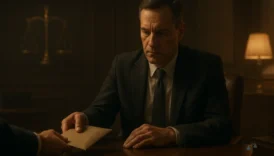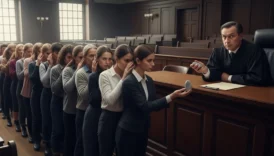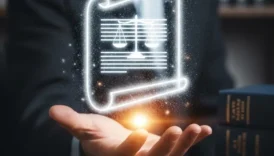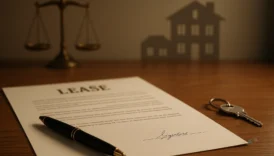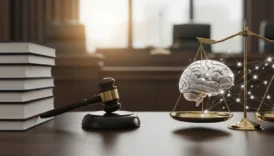Subpoena: Meaning, Definition and Examples

Simple definition of a subpoena: a formal, court-issued order that legally compels a person to appear, testify, or produce documents in a judicial or administrative proceeding.
It is one of the most powerful tools of procedural law, ensuring that truth and evidence are brought before the court.
“A subpoena is the voice of the court — it commands presence, testimony, or proof in the pursuit of justice.”
Meaning of Subpoena in Law
A subpoena (from the Latin sub poena, meaning “under penalty”) is an official writ demanding compliance under threat of legal consequences.
It ensures that individuals or entities cannot ignore the judicial process, securing necessary evidence and testimony to establish facts and administer justice.
Subpoenas are used in both civil and criminal cases, and also in administrative hearings, grand juries, and legislative inquiries.
They can compel:
- A person to testify as a witness,
- A party to provide documents or records,
- An organization to produce digital data, contracts, or communication logs.
Failure to comply with a subpoena — called contempt of court — can result in fines, sanctions, or imprisonment, depending on jurisdiction.
The Legal Basis and Historical Roots of Subpoenas
The authority of the subpoena originates from English common law, later codified into modern judicial systems across the world.
Historically, it represented the court’s inherent power to compel participation in justice — a function once exercised by royal courts and ecclesiastical tribunals.
In modern systems:
- Civil Procedure Rules and Criminal Procedure Codes define how subpoenas are issued and enforced.
- In the U.S., Federal Rule of Civil Procedure 45 governs subpoenas in civil cases.
- Other nations have similar procedural statutes ensuring due process and lawful coercion.
Historical Evolution
| Era | Development |
|---|---|
| 13th–15th Century England | Originated as royal writs compelling attendance in chancery courts. |
| 17th Century | Became integral to evidentiary procedures; failure to appear led to fines or imprisonment. |
| Modern Era | Incorporated into civil, criminal, and administrative law as a due process mechanism. |
The enduring principle: no one stands above the judicial process.
A subpoena binds individuals to truth, ensuring that courts access all relevant facts for fair adjudication.
Types of Subpoenas
Different legal systems recognize several kinds of subpoenas, depending on their purpose and the action required from the recipient.
1. Subpoena ad Testificandum (to Testify)
This subpoena compels an individual to appear and provide oral testimony under oath.
It is typically addressed to witnesses, experts, or even defendants required to explain facts firsthand.
2. Subpoena duces tecum (to Bring Documents)
Translated as “bring with you,” this order requires the recipient to produce specific documents, records, or digital data relevant to a case.
Examples include:
- Bank statements in a fraud investigation,
- Emails in an employment dispute,
- Surveillance footage in a civil negligence case.
3. Subpoena ad Respondendum (to Answer)
Less common today, this type compels a defendant to respond formally to a legal claim or charge, often in equity or administrative law contexts.
4. Legislative or Congressional Subpoenas
Used by parliaments and congresses to compel testimony or documents during investigations, reflecting the principle of governmental oversight.
5. Grand Jury Subpoenas
Issued during criminal investigations to gather evidence before indictment. They carry significant power but are also subject to constitutional limitations (e.g., Fifth Amendment privilege).
How Subpoenas Are Issued and Served
The power to issue a subpoena belongs to courts, tribunals, and authorized legal officers, including attorneys acting under court authority. The process follows strict procedural rules to ensure fairness, clarity, and proper notice.
1. Issuance of a Subpoena
A subpoena is not a casual request — it is a formal legal command.
Depending on jurisdiction, subpoenas may be issued by:
- A judge or magistrate in active proceedings,
- A court clerk on behalf of the judiciary,
- A licensed attorney, once authorized to act under specific procedural rules.
In the United States, for instance:
- Under Rule 45 of the Federal Rules of Civil Procedure, attorneys may issue subpoenas as “officers of the court.”
- In criminal cases, prosecutors and grand juries often hold this power.
- Some administrative agencies (e.g., SEC, FTC) also have subpoena authority for investigations.
Every subpoena must:
- Identify the issuing court,
- Clearly state the case title and docket number,
- Specify who must comply, what they must do, and when and where to do it,
- Include a notice of penalties for noncompliance (such as contempt of court).
Failure to meet these formalities can render a subpoena invalid or unenforceable.
2. Service of a Subpoena
Proper service ensures that the recipient is legally informed and given a fair opportunity to comply.
Service must be performed by a neutral party — someone not involved in the case — typically a process server, marshal, or sheriff.
Accepted Methods of Service:
| Method | Description | Notes |
|---|---|---|
| Personal Service | Delivered in person to the named individual. | Most common and preferred method. |
| Substitute Service | Delivered to another adult at the person’s residence or workplace. | Must be followed by mailed notice. |
| Certified Mail or Courier | Allowed in some jurisdictions for document subpoenas. | Requires proof of receipt. |
| Electronic Service | Increasingly accepted for corporations or agencies. | Must comply with data privacy laws. |
A subpoena served incorrectly — e.g., left with a minor, mailed without proof, or lacking identification — can be challenged and quashed by the court.
3. Timing and Deadlines
Subpoenas must provide reasonable time for compliance.
For instance:
- Witness subpoenas often require at least 7–14 days’ notice.
- Document production subpoenas must specify clear deadlines and locations.
In emergencies, a party may request a shortened compliance period, but only if the court agrees that urgency outweighs inconvenience.
4. Fees and Compensation
Recipients — particularly witnesses — are often entitled to fees or reimbursements for time and travel.
Examples:
- In U.S. federal courts, witnesses receive $40 per day plus travel mileage.
- Expert witnesses or professionals may request higher fees due to time loss or preparation costs.
This system ensures that subpoenas, while compulsory, remain equitable in practice.
5. Special Service Rules for Organizations
When a subpoena targets a corporation, government body, or institution, it must be delivered to an authorized representative — such as a registered agent, legal department, or compliance officer.
For digital entities (like tech companies or cloud providers), service is often completed through electronic legal portals specifically designated for subpoenas and court orders.
In every case, service marks the moment of obligation — from that point, the recipient is under the authority of the court.
Failure to comply, delay in response, or willful evasion can trigger immediate legal consequences.
Rights and Obligations Under a Subpoena
Receiving a subpoena can feel intimidating, but it is fundamentally part of the judicial process — not an accusation, but an obligation to assist in uncovering truth.
The law provides both duties and protections to ensure compliance without abuse.
1. Obligation to Comply
A subpoena carries the authority of the court. Recipients must follow its instructions exactly:
- Appear at the specified place, date, and time.
- Testify truthfully under oath (for subpoenas ad testificandum).
- Produce documents, data, or other evidence as directed (for subpoenas duces tecum).
Failure to comply without lawful excuse can lead to contempt proceedings, fines, or even arrest.
However, compliance does not mean surrendering every right — recipients may assert valid objections.
2. Right to Object or Challenge
Courts recognize that subpoenas must not be unreasonable, overly broad, or abusive.
A recipient may challenge a subpoena by filing a Motion to Quash (Cancel) or Modify the order.
Common grounds include:
- Irrelevance: The requested information has no connection to the case.
- Undue Burden: Compliance would be excessively costly, time-consuming, or invasive.
- Privilege: The material is protected (e.g., attorney–client privilege, doctor–patient confidentiality).
- Improper Service: The subpoena was not lawfully delivered or lacks required details.
- Jurisdictional Limits: The issuing court has no authority over the recipient’s location.
Courts usually balance the need for evidence against the burden on the respondent, ensuring that justice remains proportionate.
3. Privilege and Confidentiality Protections
Certain communications and records are legally shielded from disclosure.
These privileges are vital to maintaining professional trust and individual rights.
| Privilege Type | Protected Relationship / Material |
|---|---|
| Attorney–Client | Legal advice and correspondence with counsel. |
| Doctor–Patient | Medical records and health discussions. |
| Spousal | Private communication between spouses. |
| Clergy–Penitent | Religious confession or counseling. |
| Trade Secrets | Proprietary data essential to business operations. |
If privileged material is subpoenaed, the respondent must still appear but may refuse to produce or testify about specific items, asserting the privilege formally on record.
4. Right Against Self-Incrimination
Under the Fifth Amendment (U.S.) and similar constitutional provisions worldwide, individuals cannot be compelled to testify against themselves.
When invoked properly, this right limits subpoena power — especially in criminal investigations.
However, corporations and collective entities cannot claim personal privilege; they must produce documents even if they are self-incriminating organizationally.
5. Right to Legal Counsel
Anyone receiving a subpoena has the right to seek legal advice before responding.
An attorney can:
- Review scope and validity of the subpoena,
- Negotiate narrower production terms,
- Assert privileges,
- Represent the client during testimony.
Legal representation prevents accidental waiver of rights or disclosure of sensitive information.
6. Costs, Reimbursements, and Logistics
While complying, a person may incur travel, copying, or administrative expenses.
Courts often allow reasonable reimbursement, particularly for nonparty witnesses.
Large-scale document productions may be limited or cost-shared to avoid financial strain.
7. Corporate and Governmental Obligations
For organizations, compliance typically falls on records custodians or legal departments.
Failure to produce ordered material may result in institutional contempt, fines, or injunctions.
In government contexts, officials can assert sovereign or executive privilege — but only within narrow constitutional bounds.
In short, a subpoena demands respect but not blind obedience.
Law and due process ensure that compliance is lawful, reasonable, and balanced — protecting both justice and individual rights.
Practical Examples of Subpoenas in Action
A subpoena may sound abstract until one sees how it operates in real-world contexts. From criminal courts to corporate lawsuits, it is the legal mechanism that bridges speculation with evidence. Below are the key domains where subpoenas actively shape justice.
1. Civil Cases: Discovery and Evidence Production
In civil litigation, subpoenas are essential for the discovery process — the phase where parties collect information to support or defend their claims.
Example Scenario 1 — Contract Dispute
Two companies are in a breach-of-contract lawsuit.
- The plaintiff issues a subpoena duces tecum to the defendant’s accounting firm, seeking emails, invoices, and payment logs that prove nonperformance.
- The firm, though not a direct party, must comply and provide documents under oath.
- The records reveal late payments and missing signatures — decisive evidence in the trial.
Example Scenario 2 — Personal Injury Claim
A car accident victim subpoenas hospital records and surveillance footage to verify injuries and liability.
Subpoenas here serve fairness: each side gains access to material evidence otherwise inaccessible.
2. Criminal Proceedings: Testimony and Evidence
In criminal law, subpoenas are instruments of compulsion and truth — essential to both prosecution and defense.
They may compel witnesses to appear or produce crucial forensic and documentary proof.
Example Scenario 3 — Witness Compulsion
During a robbery trial, a reluctant eyewitness refuses to testify out of fear.
The court issues a subpoena ad testificandum, legally requiring the person’s presence.
Failure to appear can lead to arrest under a bench warrant for contempt.
Example Scenario 4 — Digital Evidence
Prosecutors subpoena internet service providers or cloud platforms to access logs, emails, or IP data linked to cybercrimes.
This data often becomes the linchpin in identifying suspects or proving intent.
Example Scenario 5 — Defense Rights
Defense attorneys can also issue subpoenas to obtain exculpatory evidence, such as surveillance footage proving their client’s innocence.
Thus, subpoena power protects both state authority and individual rights.
3. Administrative and Regulatory Proceedings
Government agencies often wield statutory subpoena power to enforce compliance, inspect records, or investigate wrongdoing without launching full trials.
Example Scenario 6 — Financial Regulation
The Securities and Exchange Commission (SEC) may subpoena company executives to produce internal communications about insider trading.
Noncompliance can lead to civil penalties or referral for criminal prosecution.
Example Scenario 7 — Labor and Employment Disputes
The Equal Employment Opportunity Commission (EEOC) issues subpoenas during workplace discrimination investigations.
Employers must provide HR files, payroll data, or internal complaints — ensuring transparency in administrative justice.
Example Scenario 8 — Legislative Oversight
Congressional or parliamentary committees issue subpoenas during national inquiries — for example, investigating public spending or political corruption.
Failure to comply may result in contempt of Congress, triggering fines or detention.
4. International Cooperation and Cross-Border Subpoenas
In an increasingly globalized legal landscape, subpoenas may extend across jurisdictions.
Courts rely on mutual legal assistance treaties (MLATs) or letters rogatory to request evidence from foreign entities.
For instance:
- A U.S. court may subpoena documents held by a European subsidiary through diplomatic channels.
- A multinational corporation may face coordinated subpoenas from several countries investigating antitrust violations.
While these cross-border tools resemble subpoenas, they depend on international comity rather than domestic enforcement power.
5. Corporate and Digital Age Subpoenas
Modern technology has expanded subpoena scope dramatically.
Today, they cover emails, server logs, encrypted chats, metadata, and digital devices.
Courts have adapted by:
- Allowing electronic production of records via secure uploads,
- Requiring data authenticity certificates,
- Protecting user privacy through redaction or protective orders.
These developments reflect the subpoena’s adaptability: an ancient writ serving modern justice.
Enforcement of Subpoenas and Contempt of Court
A subpoena carries the full weight of judicial authority — but its power depends on enforcement.
Courts must ensure that those who receive a subpoena either comply or face sanctions for defiance.
The mechanism that ensures compliance is known as contempt of court — the judiciary’s tool to uphold its own dignity and lawful orders.
1. What Happens When Someone Ignores a Subpoena
Ignoring a subpoena is not merely impolite — it’s a violation of law.
If a person fails to appear, refuses to testify, or withholds required documents without justification, the court may:
- Issue a show cause order, demanding explanation,
- Impose monetary fines,
- Authorize arrest and detention, or
- Initiate civil or criminal contempt proceedings.
Civil contempt seeks compliance (e.g., jail until the person agrees to testify), while criminal contempt punishes disobedience as an offense against the court itself.
2. Judicial Tools for Enforcement
Courts possess several procedural tools to enforce subpoenas and preserve authority:
| Enforcement Tool | Description | Purpose |
|---|---|---|
| Bench Warrant | Authorizes law enforcement to arrest a noncompliant witness. | Ensures physical appearance. |
| Contempt Fines | Daily or lump-sum penalties for defiance. | Encourages cooperation. |
| Incarceration for Civil Contempt | Temporary detention until compliance. | Coercive, not punitive. |
| Attachment Orders | Seizure of documents or property subject to subpoena. | Secures evidence. |
| Default Judgment | In civil cases, the noncompliant party may lose automatically. | Discourages obstruction. |
These powers underline the fundamental principle: courts must be obeyed, not negotiated with.
3. Limits on Enforcement Power
Despite their strength, subpoena enforcement mechanisms are bounded by due process.
A person must be given:
- Proper notice of the subpoena,
- A reasonable opportunity to comply, and
- A hearing before serious penalties like imprisonment are imposed.
Arbitrary or excessive use of contempt power can itself be overturned on appeal.
Courts strive to use least restrictive means — encouraging voluntary cooperation first, coercion last.
4. High-Profile Real-World Examples
Example 1 — Corporate Refusal to Produce Records
In 2002, a major energy corporation ignored congressional subpoenas for internal memos. The committee pursued contempt proceedings, resulting in executive fines and a damaging public inquiry.
Example 2 — Witness Defying a Grand Jury Subpoena
A key witness in a fraud investigation repeatedly refused to testify, citing personal risk. The judge ordered confinement until the witness complied, resulting in eventual cooperation after ten days in custody.
Example 3 — Governmental Resistance
Occasionally, executive officials resist legislative subpoenas, invoking executive privilege. Courts then balance separation of powers against the public’s right to information.
Famous examples include U.S. v. Nixon (1974), where subpoena enforcement revealed the limits of presidential secrecy.
5. Contempt as a Deterrent and Safeguard
Contempt powers are not meant to intimidate; they preserve respect for the judicial process.
If subpoenas could be ignored without consequence, the courts would lose their ability to function.
At the same time, judges exercise restraint to ensure that coercion never replaces justice.
“The rule of law depends not on fear of the court, but on faith in its fairness.”
6. Enforcement in the Digital Age
Modern subpoena enforcement faces new challenges:
- Cloud-based data may reside in multiple jurisdictions.
- Companies use encryption and privacy laws to resist overreach.
- Cross-border compliance requires cooperation under treaties and mutual assistance laws.
Courts increasingly rely on electronic service, digital forensics orders, and third-party data custodians to adapt subpoena power to modern realities.
Why Subpoenas Matter to Justice and Democracy
A subpoena is far more than a piece of legal paper — it is a symbol of the rule of law itself.
Through it, courts assert that no person, organization, or government is beyond accountability.
At its core, the subpoena embodies three fundamental values:
truth, fairness, and access to justice.
1. Ensuring Truth and Accountability
Without subpoenas, witnesses could simply ignore proceedings, and crucial documents might remain hidden.
The subpoena ensures that courts can:
- Obtain honest testimony from those who witnessed key events,
- Access records and evidence necessary for fair decisions,
- Hold both citizens and corporations answerable to the law.
In this sense, subpoena power transforms justice from theory into practice — it’s the engine that drives factual discovery.
Real Example:
In the Enron scandal, congressional subpoenas unearthed internal memos exposing fraud and concealment.
Without those writs, millions of investors would have been denied justice.
This exemplifies the subpoena’s role as a democratic equalizer — forcing even the powerful to disclose truth.
2. Protecting the Integrity of the Legal System
The subpoena is an instrument of balance and integrity.
It allows the court to function on verified evidence rather than assumption or rumor.
Each served document, each testimony under oath, reinforces the notion that justice is built on facts, not privilege.
Without it:
- Civil trials would devolve into guesswork,
- Criminal prosecutions would lack foundation,
- Administrative and legislative oversight would lose teeth.
“The subpoena is not a weapon — it is the bridge between authority and accountability.”
3. Subpoenas as Tools of Equality Before the Law
The principle “no one is above the law” gains meaning only when courts can compel truth from all.
Whether the respondent is a billionaire CEO, a government official, or an ordinary citizen, the subpoena equalizes their duty to justice.
This principle protects:
- Democracy, by restraining unchecked power,
- Citizenship, by affirming shared legal duties,
- Transparency, by enabling public scrutiny of institutional behavior.
4. Ethical Responsibilities in Using Subpoenas
Because subpoenas are so powerful, they must be used responsibly.
Attorneys and investigators are ethically bound to avoid harassment, overreach, or fishing expeditions.
Key Ethical Standards:
- Subpoenas must serve legitimate legal purpose, not personal interest.
- Scope must be narrow and specific, targeting only relevant material.
- Confidential or privileged data must be handled with care and redaction.
- Subpoenas must not be used as tactics of intimidation or retaliation.
Bar associations and courts can sanction lawyers who misuse subpoenas to harass witnesses or leak private data.
5. Balancing Public Interest and Privacy
The rise of digital communication has blurred the line between private and public domains.
Subpoenas seeking phone logs, emails, or social media data test the limits of privacy law.
Courts now weigh:
- Public interest in uncovering truth
vs. - Individual privacy under constitutional protections.
Judges frequently issue protective orders to limit disclosure, seal sensitive records, or anonymize third-party data.
Thus, subpoena law evolves alongside societal values — always reinterpreting fairness in the light of new technology.
6. Subpoenas and the Modern Rule of Law
Every subpoena issued represents a reaffirmation of civil order — a written demand that truth be told and justice done.
From local courts to international tribunals, this centuries-old tool continues to uphold democracy by ensuring that facts, not influence, decide outcomes.
In the courtroom, a subpoena is not merely a command — it is the law speaking through the voice of reason.
The Future of Subpoenas in the Digital Age
The subpoena — a centuries-old legal tool — is now being reshaped by technology, globalization, and evolving notions of privacy.
While its purpose remains constant — to compel truth and evidence — the methods of service, scope of data, and enforcement mechanisms are transforming rapidly.
1. Digital Service and Virtual Testimony
Courts are increasingly allowing electronic subpoenas served via email, encrypted portals, or verified digital signatures.
This shift ensures faster communication while maintaining legal authenticity.
- Witnesses may now testify remotely via secure video conferencing, particularly in international cases or public health crises.
- Cloud-based evidence systems allow recipients to upload materials digitally, verified through metadata and blockchain-based audit trails.
- E-signatures replace ink seals, marking a new era of procedural efficiency.
However, these conveniences raise challenges — ensuring identity verification, cybersecurity, and chain-of-custody integrity remain top priorities for judicial systems.
2. AI and Automated Evidence Discovery
Artificial intelligence now assists in subpoena compliance by scanning vast databases for relevant records.
While efficient, it creates new ethical debates:
- Can algorithms decide what’s “relevant evidence”?
- Who bears liability if AI overlooks or exposes confidential information?
- How should courts interpret machine-processed data?
The future likely involves hybrid subpoena protocols — where automation assists but does not replace human legal oversight.
3. Cross-Border and Cyber Jurisdiction
Global communication platforms challenge traditional subpoena boundaries.
A witness or data server might be located halfway around the world — beyond domestic authority.
To address this, nations are expanding Mutual Legal Assistance Treaties (MLATs) and cloud data accords.
Tech giants like Google, Meta, and Microsoft have developed dedicated “law enforcement request portals” to streamline lawful data sharing while respecting privacy law.
These evolving frameworks redefine what it means to “serve” a subpoena in the 21st century.
4. Balancing Transparency and Digital Rights
The digital revolution has made information infinitely accessible — and equally vulnerable.
Courts must continuously balance:
- Transparency: Ensuring truth reaches the court,
- Digital Rights: Protecting personal data, trade secrets, and encryption.
Future subpoena practice will likely include:
- Stronger data minimization principles,
- Clearer international privacy standards, and
- Broader judicial cooperation networks.
This evolution ensures that justice remains modern, relevant, and humane — never static.
Summary and Final Reflections
A subpoena is both a command and a safeguard — a bridge connecting law’s authority with truth’s necessity.
It compels not to punish, but to ensure that justice operates on evidence, not assumption.
Whether issued to a reluctant witness, a powerful corporation, or a digital platform, its purpose endures: to illuminate facts hidden in shadow.
- In civil law, it preserves fairness.
- In criminal law, it protects due process.
- In democracy, it enforces accountability.
“The subpoena endures because truth still matters — and courts still listen.”
Thus, in an era of data clouds, encrypted servers, and virtual hearings, the subpoena stands as an ancient yet ever-adapting symbol of justice — proving that even in the digital age, the rule of law still speaks with human voice.
FAQ — Legal Subpoenas
What is a subpoena in simple terms?
A subpoena is a court order that legally requires someone to appear, testify, or provide documents in a legal case.
Ignoring it can lead to fines or even jail, because it represents the court’s authority to uncover the truth and ensure fairness.
Who can issue a subpoena?
Judges, court clerks, attorneys, and certain government agencies have the power to issue subpoenas.
In most civil and criminal cases, lawyers acting as officers of the court can prepare and serve them under procedural rules such as Rule 45 in the U.S. Federal system.
What happens if you ignore a subpoena?
Failing to comply with a subpoena may result in contempt of court, leading to fines, arrest, or detention until compliance.
Courts take noncompliance seriously, as it undermines the authority of the justice system.
Can I challenge or refuse a subpoena?
Yes. You may file a motion to quash if the subpoena is unreasonable, overly broad, or violates privilege or privacy.
Courts often narrow subpoenas to protect fairness while still preserving access to essential evidence.
What types of subpoenas exist?
The two most common are subpoena ad testificandum (requiring testimony) and subpoena duces tecum (requiring documents).
Both compel cooperation but serve different roles — one demands presence, the other production.
Are there any rights or protections for people served with subpoenas?
Yes. Recipients have rights to legal counsel, to object on grounds of privilege, and to request reasonable time to comply.
They may also receive compensation for travel or document production expenses.
Can a subpoena force me to testify against myself?
No. Under constitutional law, such as the Fifth Amendment in the U.S., you cannot be compelled to self-incriminate.
However, this protection applies to individuals — not corporations or collective entities.
What is a grand jury subpoena?
A grand jury subpoena is issued during criminal investigations to gather evidence before indictment.
It allows prosecutors to call witnesses or demand documents in secret proceedings aimed at determining whether charges should be filed.
Are electronic or email subpoenas legal?
Yes, many jurisdictions now recognize electronic service, especially for corporations or digital evidence requests.
However, authenticity and security are strictly regulated to prevent misuse.
Why are subpoenas important for justice?
Because they ensure transparency, accountability, and equality under the law.
Subpoenas make it possible for courts to reach the truth, compelling everyone — from private citizens to powerful institutions — to respect the same legal process.
Author & Editorial Note
Author: Legal Terms
Last Updated: October 2025
Disclaimer: This article provides general educational information about subpoenas and procedural law. It does not constitute legal advice or create an attorney–client relationship.

